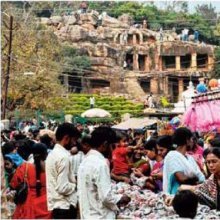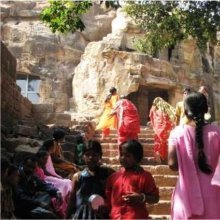Mela, Melā: 22 definitions
Introduction:
Mela means something in Buddhism, Pali, Hinduism, Sanskrit, Marathi, Jainism, Prakrit, Hindi, biology, Tamil. If you want to know the exact meaning, history, etymology or English translation of this term then check out the descriptions on this page. Add your comment or reference to a book if you want to contribute to this summary article.
Images (photo gallery)
In Hinduism
Natyashastra (theatrics and dramaturgy)
Source: archive.org: The Ragas Of Karnatic MusicMelā (मेला).—According to Śrīnivāsa, a meḷa (melā) is a group of notes revealing the rāga. The meḷa is of three kinds, viz.,
- sampūrṇa,
- ṣāḍava,
- auḍava.
Ahobala in his Saṅgīta-pārijāta (17th century) uses the term meḷa simply to mean a rāga. He says that meḷas (melās) are made of śuddha and vikṛta-svaras and groups them into pūrṇa, ṣāḍava and auḍava varieties. He arrives at a total of 11,340 meḷas which, he says, were discovered by him.
Source: WikiPedia: NatyashastraBy the time Venkatamakhin formulated the melakarta ("mela") system, the grama system was no longer in use. Unlike the grama system, the mela system uses the same starting svara. It forms the scales by varying the intervals of the subsequent svaras, and does not specify a fixed interval for a svara in terms of shrutis.

Natyashastra (नाट्यशास्त्र, nāṭyaśāstra) refers to both the ancient Indian tradition (shastra) of performing arts, (natya—theatrics, drama, dance, music), as well as the name of a Sanskrit work dealing with these subjects. It also teaches the rules for composing Dramatic plays (nataka), construction and performance of Theater, and Poetic works (kavya).
Ayurveda (science of life)
Nighantu (Synonyms and Characteristics of Drugs and technical terms)
Source: WorldCat: Rāj nighaṇṭuMelā (मेला) is another name for Mahānīlī which is a variety of Nīlī: a medicinal plant possibly identified with Indigofera tinctoria Linn. (“true indigo”), according to verse 4.80-83 of the 13th-century Raj Nighantu or Rājanighaṇṭu. The fourth chapter (śatāhvādi-varga) of this book enumerates eighty varieties of small plants (pṛthu-kṣupa). Together with the names Melā and Mahānīlī, there are a total of eight Sanskrit synonyms identified for this plant.

Āyurveda (आयुर्वेद, ayurveda) is a branch of Indian science dealing with medicine, herbalism, taxology, anatomy, surgery, alchemy and related topics. Traditional practice of Āyurveda in ancient India dates back to at least the first millenium BC. Literature is commonly written in Sanskrit using various poetic metres.
Shaktism (Shakta philosophy)
Source: Google Books: ManthanabhairavatantramMela (मेल) refers to “union”, according to the Mahānayaprakāśa verse 2.1-35, while explaining the cycles of the goddesses of consciousness.—Accordingly, “That same (energy of consciousness) is the (goddess) who devours destruction (saṃhārabhakṣiṇī). She is the perception consisting of the manifestation of all things within supreme consciousness in a state of oneness (sāmarasya), and so is Union (mela). The inner abiding state of the light (of consciousness) as a state of oneness is the withdrawal of (all) manifestations (ābhāsa) (brought about) when this same (energy) has turned in on itself in all respects (samantata). [...]”.

Shakta (शाक्त, śākta) or Shaktism (śāktism) represents a tradition of Hinduism where the Goddess (Devi) is revered and worshipped. Shakta literature includes a range of scriptures, including various Agamas and Tantras, although its roots may be traced back to the Vedas.
In Buddhism
Tibetan Buddhism (Vajrayana or tantric Buddhism)
Source: academia.edu: A Critical Study of the Vajraḍākamahātantrarāja (II)Melā (मेला) refers to the “secret meeting” with native women in Tantric Buddhism, according to the 9th-century Vajraḍākatantra. Accordingly, the Vajraḍākatantra tells that the secret meeting is held at night especially in the holy districts together with native women. Identification of one’s ritual fellow, communication and some ritual proceeding sare supposed to be done with secret signs (chomā). Chapter 18.75 give some information on places where the meeting is geld i.e. local fields or seats of goddesses, town or village, or the top of the mountain.
Chapter 36 argues concisely about the content of the meeting (melā), focussing particularly on the importance of the sexual yoga. Every day, every month or every year, or in accordance with the time when “empowerment” arises in one’s body, a Yogin should perform ‘dance’ (nāṭya) (=sexual yoga) to obtain the accomplishment of mudrā.

Tibetan Buddhism includes schools such as Nyingma, Kadampa, Kagyu and Gelug. Their primary canon of literature is divided in two broad categories: The Kangyur, which consists of Buddha’s words, and the Tengyur, which includes commentaries from various sources. Esotericism and tantra techniques (vajrayāna) are collected indepently.
Biology (plants and animals)
Source: Google Books: CRC World Dictionary (Regional names)1) Mela in Togo is the name of a plant defined with Sorghum bicolor in various botanical sources. This page contains potential references in Ayurveda, modern medicine, and other folk traditions or local practices It has the synonym Panicum frumentaceum Salisb. (among others).
2) Mela in Upper Volta is also identified with Pennisetum glaucum It has the synonym Cenchrus spicatus (L.) Kuntze, nom. illeg., non Cenchrus spicatus (L.) Cav. (etc.).
Example references for further research on medicinal uses or toxicity (see latin names for full list):
· Flora Peruviana (1798)
· Saggi scientifici e letterarj dell’ accademia di Padova (1786)
· Amer. Journal of Botany (1977)
· Nomenclator Botanicus. Editio secunda (1841)
· Economic Botany (2004)
· Bulletin of Miscellaneous Information Kew (1933)
If you are looking for specific details regarding Mela, for example health benefits, side effects, chemical composition, pregnancy safety, extract dosage, diet and recipes, have a look at these references.

This sections includes definitions from the five kingdoms of living things: Animals, Plants, Fungi, Protists and Monera. It will include both the official binomial nomenclature (scientific names usually in Latin) as well as regional spellings and variants.
Languages of India and abroad
Marathi-English dictionary
Source: DDSA: The Molesworth Marathi and English Dictionarymēlā (मेला).—f (S & H) Popularly mēḷā.
--- OR ---
mēlā (मेला).—m or a (The preterit of maraṇēṃ used as a noun or an adjective.) A dead person, or dead. This is the never-failing term of abuse by females to or of an offending male, implying that he is but a corpse or carcass. 2 Dead, i. e. flat, stale, spiritless, vapid &c. Used in variations of this sense in combination with numerous nouns of all classes; as mēlā cunā Dead lime,--lime that has been wrought up into mortar and applied in building. mēlī bhākara Dead bread,--food obtained without service or labor; bread of idleness. See mēlēṃ anna. mēlī mātī Earth that has been used or applied (in building). 2 Dry, ununctuous, uncohering earth. 3 Rotten earth: also earth of saline incrustations. mēlēṃ anna Dead victuals or provision, -food got without working for it (i. e. in the dishonorable way of sponging or, when uncanonical, begging); "res non parta labore." v khā. mēlēṃ kātaḍēṃ Dead skin. mēlēṃ kāma Any lifeless work or business; any mere labor devoid of excitement or exercise for mind or heart. mēlēṃ tūpa The residue of a quantity of ghee after consumption or application. mēlēṃ tēla Oil (as of a lamp) remaining unconsumed, stale oil. mēlēṃ nakha Dead, dry, or fungous nail. mēlēṃ pāṇī Water deprived of its air through boiling or heating: also water that has been used or applied. mēlēṃ māsa Dead or proud flesh. mēlēṃ rakta Dead (i. e. extravasated) blood: also effused blood, gore: also semi-animate or poor blood, as that of aged persons. mēlēṃ rājya An extinct sovereignty or sway. mēlēṃ lihiṇēṃ Unengaging or uninteresting writing, i. e. the business of copying. mēlēṃ hatyāra or -hatēra A hollow or untrusty weapon, i. e. a musket, matchlock, cannon &c. which, under whatever management, may yet fail of discharging its ball. Opp. to jīvanta hatyāra. mēlyācā pāḍa caḍhaṇēṃ or jāṇēṃ in. con. To become of the value of a corpse, i. e. to lose all value. mēlyācyā māgēṃ kōṇhī marata nāhīṃ No one dies because of the death of another; i. e. no one absolutely gives up his life because of a privation or loss.
--- OR ---
mēḷa (मेळ).—m (mēla S) Agreement, concord, harmonious consistency together. 2 Agreement, tally, balancing (as of an account). 3 A band (of musicians &c.) 4 A couple of serpents in coitu. 5 The efflorescence of the bamboo &c.
--- OR ---
mēḷā (मेळा).—m (mēlā S) A concourse of people; a gathering or an assembly; esp. as at stated periods for religious or commercial purposes; a fair &c. v bhara, jama. 2 A company of arbitrators: hence Judgment by arbitration, or a judgment passed. mēḷyāsa miḷaṇēṃ To join or unite with; to go over unto and amongst as one of.
Source: DDSA: The Aryabhusan school dictionary, Marathi-Englishmēlā (मेला).—m or a A dead person or dead. mēlēlā p Dead.
--- OR ---
mēḷa (मेळ).—m Agreement; tally. A band.
--- OR ---
mēḷā (मेळा).—m A concourse of people; a gather- ing. Judgment by arbitration.
Marathi is an Indo-European language having over 70 million native speakers people in (predominantly) Maharashtra India. Marathi, like many other Indo-Aryan languages, evolved from early forms of Prakrit, which itself is a subset of Sanskrit, one of the most ancient languages of the world.
Sanskrit dictionary
Source: DDSA: The practical Sanskrit-English dictionaryMela (मेल).—[mil-ghañ]
1) Meeting, union, intercourse.
2) A fair.
3) A company, an assembly.
4) Conjunction (of planets). (Also melaka).
Derivable forms: melaḥ (मेलः).
--- OR ---
Melā (मेला).—[mil-ṇic ac ṭāp]
1) Union, intercourse.
2) A company, assembly, a society.
3) Antimony.
4) The indigo plant.
5) Ink.
6) A musical scale.
Source: Cologne Digital Sanskrit Dictionaries: Edgerton Buddhist Hybrid Sanskrit DictionaryMela (मेल).—m. (1) a high number: Mahāvyutpatti 7768 = Tibetan (ḥ)phrad yas = melu, q.v.; (2) name of a nāga king, in [compound] Ela-melau, dual dvandva: Mahāvyutpatti 3291 (so read with v.l., also v.l. in Mironov and Tibetan, see s.v. Ela-mela); Mahā-Māyūrī 247.33.
--- OR ---
Melā (मेला).—= next: Gaṇḍavyūha 106.12.
Source: Cologne Digital Sanskrit Dictionaries: Shabda-Sagara Sanskrit-English DictionaryMela (मेल).—mf.
(-laḥ-lā) Meeting, union, assemblage; in the modern dialects, applied to a large concourse of people collected at stated periods for religious or commercial purposes, as at Haridwar, &c. f.
(-lā) 1. Ink. 2. Antimony or any collyrium. 3. Union, intercourse. 4. A company, a society. 5. The indigo-plant. 6. A musical scale. E. mila to mix, to meet, aff. ghañ; also with lyuṭ aff. melana .
Source: Cologne Digital Sanskrit Dictionaries: Benfey Sanskrit-English DictionaryMela (मेल).—i. e. mil + a, I. m., and f. lā, Assemblage, meeting, [Pañcatantra] 245, 4 (lā). Ii. f. lā, Ink (borrowed from ).
Source: Cologne Digital Sanskrit Dictionaries: Cappeller Sanskrit-English DictionaryMela (मेल).—[masculine] ā [feminine] meeting, assembly.
Source: Cologne Digital Sanskrit Dictionaries: Monier-Williams Sanskrit-English Dictionary1) Mela (मेल):—m. (√mil) meeting, union, intercourse, [Kāvya literature; Kathāsaritsāgara]
2) Melā (मेला):—[from mela] a f. See below.
3) [from mela] b f. an association, assembly, company, society, [Pañcatantra]
4) [v.s. ...] a musical scale, [Catalogue(s)] (perhaps, m(mela). )
5) [v.s. ...] a [particular] high number, [Buddhist literature]
6) [v.s. ...] any black substance used for writing, ink, [cf. Lexicographers, esp. such as amarasiṃha, halāyudha, hemacandra, etc.]
7) [v.s. ...] antimony, eye-salve, [cf. Lexicographers, esp. such as amarasiṃha, halāyudha, hemacandra, etc.]
8) [v.s. ...] the indigo plant, [cf. Lexicographers, esp. such as amarasiṃha, halāyudha, hemacandra, etc.]
Source: Cologne Digital Sanskrit Dictionaries: Yates Sanskrit-English DictionaryMela (मेल):—[(laḥ-lā)] 1. m. f. Meeting, union; assemblage. f. Ink; collyrium.
Source: DDSA: Paia-sadda-mahannavo; a comprehensive Prakrit Hindi dictionary (S)Mela (मेल) in the Sanskrit language is related to the Prakrit words: Mela, Melava, Melāva.
[Sanskrit to German]
Sanskrit, also spelled संस्कृतम् (saṃskṛtam), is an ancient language of India commonly seen as the grandmother of the Indo-European language family (even English!). Closely allied with Prakrit and Pali, Sanskrit is more exhaustive in both grammar and terms and has the most extensive collection of literature in the world, greatly surpassing its sister-languages Greek and Latin.
Hindi dictionary
Source: DDSA: A practical Hindi-English dictionary1) Mela (मेल) [Also spelled male]:—(nm) concord; consonance, agreement; match; mixture, combination; unity; conciliation; connection; mail train; —[kā] matching; -[jola/milāpa] intimacy; reconciliation, rapprochement; union; —[gāḍī] a mail train; -[mulākāta] approach; association, friendly relationship; -[mohabbata] mutual goodwill / affection; —[khānā] to match; to be in agreement.
2) Melā (मेला):—(nm) a fair; festival crowd; -[ṭhelā] fanfare, hustle and bustle, crowd and confusion; —[uṭhanā] festivities to come to an end; —, [cāra dina kā] a short-lived attraction.
...
Prakrit-English dictionary
Source: DDSA: Paia-sadda-mahannavo; a comprehensive Prakrit Hindi dictionary1) Mela (मेल) in the Prakrit language is related to the Sanskrit word: Mela.
2) Mela (मेल) also relates to the Sanskrit word: Mela.
Prakrit is an ancient language closely associated with both Pali and Sanskrit. Jain literature is often composed in this language or sub-dialects, such as the Agamas and their commentaries which are written in Ardhamagadhi and Maharashtri Prakrit. The earliest extant texts can be dated to as early as the 4th century BCE although core portions might be older.
Kannada-English dictionary
Source: Alar: Kannada-English corpus[Cf. Mēlana]
Mēla (ಮೇಲ):—
1) [noun] the state of being associated; companionship; fellowship; partnership; association.
2) [noun] a combination of parts into a pleasing or orderly whole; congruity; harmony.
3) [noun] agreement in feeling, action, ideas, interests, etc.; peaceable or friendly relations.
4) [noun] a large number of persons or things gathered together; a multitude.
5) [noun] a group of persons gathered together to transact a business, disccuss, etc.; an assembly.
6) [noun] something that entertains; an interesting, diverting or amusing thing; entertainment.
7) [noun] a gathering of people held usu. at regular intervals for barter and sale of goods; a fair.
8) [noun] a group of actors, singers, etc.; company; a troupe.
9) [noun] a programme of dance or vocal or instrumental music, in which a number of artists perform together; a concert.
10) [noun] connection of persons by blood, marriage, etc.; kinship; relation.
11) [noun] any thing that is or person who is equal.
12) [noun] a struggle for victory or superiority, a competition; a contest.
13) [noun] (fig.) a long, pitiful cry of grief and pain by several people together.
--- OR ---
Mēḷa (ಮೇಳ):—
1) [noun] the state of being associated; companionship; fellowship; partnership; association.
2) [noun] a combination of parts into a pleasing or orderly whole; congruity; harmony.
3) [noun] agreement in feeling, action, ideas, interests, etc.; peaceable or friendly relations.
4) [noun] a large number of persons or things gathered together; a multitude.
5) [noun] a group of persons gathered together to transact a business, disccuss, etc.; an assembly.
6) [noun] something that entertains; an interesting, diverting or amusing thing; entertainment.
7) [noun] a gathering of people held usu. at regular intervals for barter and sale of goods; a fair.
8) [noun] a group of actors, singers, etc.; company; a troupe.
9) [noun] a programme of dance or vocal or instrumental music, in which a number of artists perform together; a concert.
10) [noun] connection of persons by blood, marriage, etc.; kinship; relation.
11) [noun] any thing that is or person who is equal.
12) [noun] a struggle for victory or superiority, a competition; a contest.
13) [noun] (fig.) a long, pitiful cry of grief and pain of several people together.
Kannada is a Dravidian language (as opposed to the Indo-European language family) mainly spoken in the southwestern region of India.
Tamil dictionary
Source: DDSA: University of Madras: Tamil LexiconMēlā (மேலா) noun perhaps from மேல். [mel.] Superior or higher authorities; மேற்பட்ட அதிகாரஸ்தானம். மேலாவிலிருந்து உத்தரவு வந்தது. [merpatta athigarasthanam. melavilirunthu utharavu vanthathu.] Local usage
--- OR ---
Mēlā (மேலா) [mēlāttal] [mēl-ā] 12 transitive verb < idem. + ஆ⁷-. [a⁷-.] To turn upward; மேற்புறமாக்குதல். (யாழ்ப்பாணத்து மானிப்பாயகராதி) [merpuramakkuthal. (yazhppanathu manippayagarathi)]
--- OR ---
Mēlā (மேலா) [mēlātal] [mēl-ā] intransitive verb < idem. + ஆ⁶-. [a⁶-.] To excel; சிறத்தல். [sirathal.] Colloq.
Tamil is an ancient language of India from the Dravidian family spoken by roughly 250 million people mainly in southern India and Sri Lanka.
See also (Relevant definitions)
Starts with (+146): Mela-khanu, Mela-sanjoga, Melada pahit, Meladhikara, Meladhikari, Meladi, Meladu, Melagalega, Melagana, Melagara, Melagarti, Melagattu, Melagita, Melagite, Melagollu, Melagolu, Melagudu, Melai, Melaiccamuttiram, Melaiccitamparam.
Ends with (+52): Alamela, Amela, Amelaamela, Anamela, Ardhamela, Bemela, Bharmela, Camela, Cokhamela, Dhamela, Dharamela, Dumela, Dvadamela, Ekatarimela, Elamela, Gamela, Gelamela, Ghalamela, Ghamela, Godamela.
Full-text (+103): Melava, Melambu, Melananda, Melandhu, Melaka, Melamanda, Melana, Melandhuka, Melajama, Melavattiyam, Melakkacceri, Melatalam, Melanandaya, Melamani, Melakartta, Melekari, Melakarar, Manamilau, Jita, Ragalakshana.
Relevant text
Search found 19 books and stories containing Mela, Melā, Mēḷā, Mēḷa, Mēlā, Mēla, Mēl-ā, Mel-a, Melaa, Maelaa; (plurals include: Melas, Melās, Mēḷās, Mēḷas, Mēlās, Mēlas, ās, as, Melaas, Maelaas). You can also click to the full overview containing English textual excerpts. Below are direct links for the most relevant articles:
Jainism in Odisha (Orissa) (by Ashis Ranjan Sahoo)
Reason in Carnatic Music < [April 1949]
A Garland for the Myriad-Minded Sankara < [July – September, 2002]
The Soul < [January 1957]
Gati in Theory and Practice (by Dr. Sujatha Mohan)
Bhāgavata-mela Nāṭaka < [Chapter 4 - Practice of Gati]
Lord Jhulelal: An Analytical Study (by Thakkar Harish Gopalji)
Part 5.16 - Kalamjo Sipahi < [Chapter 2 - Literature Review]
Part 24 - References of Lord Jhulelal found in Government Gazetteers of Sindh < [Chapter 2 - Literature Review]
Temples in and around Madurantakam (by B. Mekala)
Manavatti (wife) < [Chapter 6 - Social and Economic Activities]
The history of Andhra country (1000 AD - 1500 AD) (by Yashoda Devi)
Part 48 - Bhima and Gokarna < [Chapter XX - The Telugu Cholas (Chodas)]
Related products



